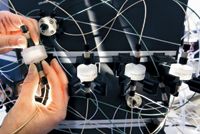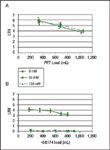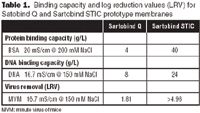Salt Tolerant Interaction Chromatography for Large-Scale Polishing with Convective Media
STIC allows polishing to be carried out without an interstitial dilution step, which reduces process time and avoids additional buffer preparation and hold steps.
ABSTRACT
Polishing applications in antibody purification are dominated by traditional anion exchange chromatography (AEX), which typically is based on strong quaternary amine (Q) ligands. Because AEX is performed in flow-through mode, membrane chromatography is steadily encroaching on the ground formerly occupied by traditional AEX columns, a change that has significantly increased the overall speed and productivity of manufacturing. However, Q membranes have not addressed any intrinsic limitations of the ligand chemistry. The binding capacity of Q ligands is reduced at high conductivities, so concentrated feed streams must be diluted to remove contaminants efficiently. To address this limitation, we have developed a novel membrane concept based on weak anion exchange chemistry that features a high charge density covalently linked to a second-generation macroporous membrane. We have named the new method salt tolerant interaction chromatography (STIC), and it is based on pure ion exchange chromatography principles. A model virus (ΦX174) was used to represent weak acidic contaminants, and showed that stable removal (LRV >5) was possible in the presence of 150-mM NaCl (16.8 mS/cm). This result was confirmed in a virus clearance study where the quantitative removal of minute virus of mice (MVM) was demonstrated under the same conditions (LRV >4.96). This new method could be incorporated into existing processes with no requirement for eluate dilution from the capture column.
Anion exchange chromatography (AEX) is an established technology platform for removing process contaminants such as host cell proteins (HCP), DNA, and adventitious and endogenous viruses. As part of the purification train for antibody-like molecules, AEX is usually carried out in flow-through mode, which has facilitated the implementation of convective media such as membrane chromatography (MC). Because flow-through applications are driven by volume rather than mass, MC modules leave a small footprint and allow for the implementation of disposables. MC, therefore, is leading the list of innovative technologies in industry surveys.1 As titers increase, the feed streams after initial recovery (capturing) become more concentrated, yet the final bulk product is still subject to the same high purity and safety requirements. It is necessary, therefore, to ensure that the polishing steps can accommodate the requirements of high-titer processes, including the removal of residual contaminants and compliance with orthogonal virus safety concepts.

Sartorius Stedim Biotech GmbH
Modern processes for antibody purification include only one or two polishing steps after initial capture, a concept that allows ton amounts of proteins to be processed and does not appear amenable to further streamlining. Although the process itself has been trimmed back as much as possible, peripheral operations such as buffer preparation and hold still offer opportunities for cost savings, particularly when retrofitting existing facilities for the purification of high titer batches. One limitation of the Q chemistry that is prevalent in polishing operations is its sensitivity to high salt conditions. Although virus clearance works well around neutral pH and at conductivities up to and even beyond 10 mS/cm, the binding capacity of Q adsorbents drops progressively as conductivity increases, leading to inefficient binding of problematic viruses such as minute virus of mice (MVM) and the early breakthrough of HCP. Feed streams eluting from the CEX step therefore must be diluted to reduce conductivity, increasing processing times, buffer requirements, and the amount of stress to which proteins are exposed. AEX with Q ligands is a robust platform that has been validated in hundreds of processes, whereas alternatives such as mixed-mode chromatography lack a clear and robust mechanism that would allow straightforward implementation during process development.
We sought to address the challenge of polishing under high-salt conditions by developing a salt-resistant AEX chemistry that meets all existing capabilities of Q ligands and can be adapted to a membrane chromatography format for polishing applications. We chose target ionic strength of approximately 16.8 mS/cm to increase the design space in process development.
Development of Salt Tolerant Interaction Chromatography (STIC)
A user requirements specification for a new standard in flow-through polishing must consider the base matrix and the ligands, both of which have to be optimized individually before identifying an optimal format for the technology. Suitable models are particularly important when specifying the design space.
The Membrane
Initial analysis of the factors limiting the performance of first-generation Q membranes (Sartobind Q) showed that the grafted hydrogel layer on the macroporous support collapses at high salt concentrations and can no longer be accessed by macromolecules and viruses.2 Therefore, we developed a second-generation base support matrix comprising a cross-linked, regenerated cellulose membrane with ultrapores, providing a novel double-porous structure. The new matrix had a significantly higher binding capacity at high salt concentrations and was less sensitive to increasing salt concentrations than standard Q membranes.
The Ligand
A recent study has shown that the salt tolerance of an anion exchange matrix is determined by the net charge of the ligand, its molecular structure, and the immobilization density.3 It was also shown that the number of free primary amine groups significantly influences the ability of a matrix to work in high salt concentrations, by compensating capacity-limitation through increased charge density.4 Polycations with multiple NH2-groups are efficient ligands and have been used to remove pathogens from blood.5 We therefore developed a polyallylamine ligand covalently coupled to the double-porous membrane described above, and investigated its contaminant removal performance at different pH and conductivity values (Figure 1).

Figure 1. Structure of the covalently attached polyallylamine on a Sartobind STIC membrane
STIC Performance Data
Although acidic contaminants such as nucleic acids and endotoxins can be removed easily under most process conditions, this is not necessarily the case for host cell proteins and viruses, especially those with a more neutral or even basic isoelectric point. It was therefore important to identify suitable "worst case" models to mimic the problem of early breakthrough under physiological conditions and investigate the behavior of the new material in spiking trials. The conductivity-related phenomenon of virus and HCP breakthrough in AEX chromatography has been described for viruses, bacteriophages, and HCP.6–8

Figure 2. Log reduction value (LRV) of a standard Sartobind Q membrane (three layers, 15 cm2 total membrane area) for bacteriophages PP7 (A) and ΦX174 (B). Load 4 x 107 pfu/mL in 25 mM Tris-Cl, pH 8.0 at a flow rate of 20 mL/min as a function of an increasing NaCl concentration of 0, 50, and 150 mM (1.4, 6.7, and 16.8 mS/cm).
To investigate the effect of increasing conductivity on both the traditional Q membrane and the new polishing chemistry, we processed phage spiking solutions comprising 4 x 107 pfu/mL in 25-mM Tris-Cl (pH 8.0) and NaCl concentrations of 0, 50, and 150 mM (1.4, 6.7, and 16.8 mS/cm). The membrane device had a three-layer configuration with a 15 cm2 membrane area (0.4 mL membrane volume, 0.75 mm bed height). The flow rate was maintained at 20 mL/min (contact time 0.9 s) in all experiments. Sample loads of up to 1,200 mL were applied per device. In the first set of experiments, we compared the binding of the bacteriophages PP7 and ΦX174 on standard Q membranes as a function of increasing conductivity at neutral pH. Although the bacteriophages have a comparable diameter (24–33 nm), their isoelectric points are distinct, with PP7 being more acidic (pI 4.3–4.9) than ΦX174 (pI 6.4–6.7).9 PP7 demonstrated no loss in binding capacity in 150-mM NaCl (16.7 mS/cm) whereas ΦX174 only bound when there was no additional salt in the Tris buffer (Figure 2). We therefore chose ΦX174 as the low-binding model virus for our study, confirming earlier results.10

Figure 3. Log reduction value (LRV) of Sartobind Q and Sartobind STIC membranes (three layers, 15 cm2 total membrane area) for the bacteriophage ΦX174. Load 4 x 107 pfu/mL in 25 mM Tris-Cl, pH 8.0 at flow rate of 20 mL/min as a function of an increasing NaCl concentration of 0 (A), 50 (B), and 150 mM (C).
In a second series of experiments, the new salt tolerant chemistry was compared with traditional Q chemistry when challenged with ΦX174 under conditions of increasing salt concentration and sample load. Although the salt tolerant chemistry achieved a log reduction value (LRV) of five at all salt concentrations up to and including physiological conditions, the performance of the Q membrane dropped sharply from its initial value of 4 LRVs at 1.4 mS/cm when challenged with higher salt concentrations or higher loads (Figure 3A–C). To confirm that these results were also applicable to actual model viruses, an MVM spiking study was carried out under high salt conditions (16.8 mS/cm), showing that no breakthrough occurred when using STIC (Table 1). The method was similarly robust when dealing with DNA and BSA (Table 1) and experiments to test the method's performance for HCP removal under typical process conditions are in progress.

Table 1. Binding capacity and log reduction values (LRV) for Satobind Q and Sartobind STIC prototype membranes
Conclusions
AEX membranes are widely used in polishing operations for the removal of residual DNA, HCP, and viruses. Current-generation benchmarks for virus removal are >6 LRVs for MuLV and MVM at loads of up to 20 kg/L of membrane, exceeding the physical performance limits of packed-bed resins.11,12 When there are significant amounts of residual HCP in the feed stream, resins still have a competitive edge, particularly at high conductivities. Recent developments in the field, including the application of higher charge densities and mixed-mode chemistries, have allowed column chromatography to address some of its limitations in flow-through applications. Membranes provide a convective matrix that allows a much higher linear flow rate in flow-through mode, offering higher productivity than packed-bed resins using a small disposable module, which can incorporate any surface chemistry.
In this study, we have shown that an optimized base support membrane matrix combined with a weak anion exchange chemistry based on polyallylamine ligands provides a robust method for virus clearance at physiological conductivities and above. STIC and traditional Q chemistry methods exhibit a clear on–off anion-exchange mechanism that can be used for the first or second polishing step after capture. STIC does not work with polyvalent buffer systems such as phosphate buffers, but because polyvalent buffers are not recommended for capturing offloads, this should not be a cause for concern in most processes. Although Q chromatography may remain the workhorse in polishing, STIC allows polishing to be carried out without an interstitial dilution step, which reduces process time and avoids additional buffer preparation and hold steps. More importantly, overall process safety is increased because of the more efficient removal of less acidic contaminants. Studies are under way to demonstrate the removal of HCP under different process conditions.
RENE FABER, PhD, is the director of membrane modification R&D and UWE GOTTSCHALK, PhD, is the vice president of Purification Technologies, at Sartorius Stedim Biotech GmbH, Goettingen, Germany, rene.faber@sartorius.com Gottschalk is also a member of BioPharm International's Editorial Advisory Board. YUJING YANG, PhD, is the director of purification technologies at Sartorius Stedim North America, Bohemia, NY.
References
1. Langer E. Sixth Annual Report and Survey of Biopharmaceutical Manufacturing Capacity and Production. BioPlan Associates Inc; 2009 Apr.
2. Tatárová I, Fáber R, Denoyel R, Polakovic M. Characterization of pore structure of a strong anion-exchange membrane adsorbent under different buffer and salt concentration conditions. J Chromatogr A. 2009;1216:941.
3. Riordan W, Heilmann S, Brorson K, Seshadri K, He Y, Etzel M. Design of salt-tolerant membrane adsorbers for viral clearance. Biotechnol Eng. 2009;103(5):920–29.
4. Johansson B, Belew M, Eriksson S, Glad G, Lind O, Mallisel J, Norrmann N., Preparation and characterization of prototypes for multi-modal separation media aimed at the capture of negatively charged biomolecules at high salt conditions. J Chromatogr A. 2003;1016:21–33.
5. Onishi M, Ohwada T, Hadanoshi K, Isehara-shi K, Ohmura Y, Shimura K. A pathogenic substance removing material and a blood filter comprising said material. European Patent Specification EP 0586268B1.
6. Curtis S, Lee K, Blank GS, Brorson K, Xu Y. Generic matrix evaluation of SV40 clearance by anion exchange chromatography in flow-through mode. Biotechnol Bioeng. 2003;84:179–186.
7. Phillips M, Cormier J, Ferrence J, Dowd C, Kiss R, Lutz H, Carter J. 2005. Performance of a membrane adsorber for trace impurity removal in biotechnology manufacturing. J Chromatogr A. 1078:74–82.
8. Knudsen H, Fahrner R, Xu Y, Norling L, Blank GS. Membrane ion-exchange chromatography for process-scale antibody purification. J Chromatogr A. 2001;907:145–154.
9. Brorson K, Shen H, Lute S, Soto J, Prez D, Frey D, Characterization and purification of bacteriophages using chromatofocusing. J Chromatogr A. 2008;1207:110–21.
10. Lute S, Aranha H, Tremblay D, Liang D, Ackermann H, Chu B, Moineau S, Brorson K. Characterization of coliphage PR772 and evaluation of its use for virus filter performance testing. Appl Environ Microbiol. 2004;70:4864–71.
11. Zhou JX, Tressel T. Basic concepts in Q membrane chromatography for large-scale antibody production. Biotechnol Prog. 2006;22:341–49.
12. Arunakumari A, Wang J, Ferreira G. Advances in non-Protein A purification processes for human monoclonal antibodies. Advances in Separation and Purification. Biopharm Intl. 2009 (Suppl);22(3):22–6.

VERAXA and Voyager to Create Combined Business for Advancing Pipeline of Next-Gen Cancer Therapies
April 23rd 2025The proposed business combination would create a publicly traded, clinical-stage biopharmaceutical company that will focus on developing a pipeline of next-generation cancer therapies.
Tokyo University of Science Research Team Explores Improved Delivery of Antisense Oligonucleotides
April 18th 2025Using cholesterol-modified oligonucleotides, the research team aims to improve the delivery of antisense nucleotide-based therapies for treating neurodegenerative diseases and brain cancers.
Thermo Fisher Opens Advanced Therapies Collaboration Center in California
April 18th 2025The 6000-square-foot facility will provide cell therapy developers the support they need to transition to CGMP manufacturing, and an expanded footprint of the new center is expected to open in Philadelphia later in 2025.